By Chris Bucholtz | 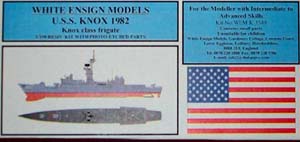 | Introduction The Knox-class of frigates were originally the low end of a high-low sea control concept. The high value ships – sea control carriers – were cancelled for budget considerations, but the Knox class destroyer escorts went ahead. The ships were 4000-ton anti-submarine warfare specialists, incorporating the lessons learned from the Battle of the Atlantic. ASW weaponry was considerable: four torpedo tubes for Mk. 32 torpedoes and an eight-shot ASROC launcher. The designıs profile was dominated by the ³mack,² or combined mast and stack, which towered over the center of the ship. 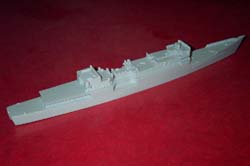 The ships had several limitations, chief among them the single shaft powerplant, which, it was feared, would leave the vessels immobilized in the event of a breakdown. The ships were also based around some weapons systems that never came into use, namely the Drone Anti-Submarine Helicopter (DASH) and the Sea Mauler surface to air missile. The failure of these systems led to major changes to the ships, including the strengthening of the flight deck and the addition of a telescoping hangar to accomodate the SH-2 Seasprite helicopter. Initially, the vessels had no missile defense against air attack, but the addition of a Sea Sparrow Basic Point Defense Missile System (BPDMS) launcher aft remedied that. The ships had several limitations, chief among them the single shaft powerplant, which, it was feared, would leave the vessels immobilized in the event of a breakdown. The ships were also based around some weapons systems that never came into use, namely the Drone Anti-Submarine Helicopter (DASH) and the Sea Mauler surface to air missile. The failure of these systems led to major changes to the ships, including the strengthening of the flight deck and the addition of a telescoping hangar to accomodate the SH-2 Seasprite helicopter. Initially, the vessels had no missile defense against air attack, but the addition of a Sea Sparrow Basic Point Defense Missile System (BPDMS) launcher aft remedied that. For all their limitations, the Knox-class ships were a bargain at about $33 million apiece, and the 46 Knox-class destoyer escorts represent the largest single class of warships built by any western navy since World War II. In 1975, they were redesignated as frigates. They served from 1969 until the early 1990s, when they were retired in favor of the more capable Oliver Hazard Perry-class frigates. The Kit White Ensignıs kit depicts the ship as it appeared in 1982 after modifications to the bow for better seakeeping qualities. This could be one of the toughest reviews of a kit Internet Modeler has ever run, because your reviewer was a bosunıs mate aboard U.S.S. Gray (FF-1054). That makes this the equivalent of writing a review of a model of your house – the subject is very well known, so be prepared for some intensive nitpicking which could lead to a more accurate model! 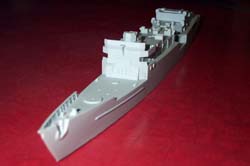 The kit itself is a great start. Itıs comprised of 42 resin and white metal parts, including the Seasprite, and a sheet of photoetched brass. The decal sheet includes markings for all 46 ships of the class, although red warning circles for the turret and launchers are absent. The kit itself is a great start. Itıs comprised of 42 resin and white metal parts, including the Seasprite, and a sheet of photoetched brass. The decal sheet includes markings for all 46 ships of the class, although red warning circles for the turret and launchers are absent. The kit give you the option of building either a full-hull or waterline model by breaking the lower hull from the upper hull and superstructure. The lower hull includes the bilge fins, shaft and sonar dome. Note the position of the sonar dome; it made dropping the bow anchor while the ship was moving forward a potentially expensive proposition! The upper hull is very well done, with all the major parts of the ship captured. Especially nice is the detail around the reloading hatches for the ASROC launcher. The detail freaks will be pleased by the fire hoses and fog applicators stored back aft below the flight deck and by the handling of the vents atop the superstructure. As a former member of deck division, I can virtually walk the length of the ship and point out minor omissions. However, I can only do this because the basics are captured so exquisitely in the kit. If youıre a stickler for detail, come walk with me. 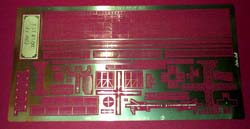 Weıll start on the foıcısle. The enlarged bulwarks of the 1982-era refit are here, although the casting is a little messy right at the inside point of the bow and some careful file work is needed. The bulwarks are thick, but not too thick to live with. Youıll probably want to drill out the through-the-bulwark chocks. The capstan is present, but the anchor brake and associated shield are missing and really ought to be added. Also not present is the raised hatch that provided access to the bosunıs locker, through which all the forward mooring lines and associated tackle was arduously passed up. Another raised hatch is absent just in front of the 5²/38 caliber turret. Weıll start on the foıcısle. The enlarged bulwarks of the 1982-era refit are here, although the casting is a little messy right at the inside point of the bow and some careful file work is needed. The bulwarks are thick, but not too thick to live with. Youıll probably want to drill out the through-the-bulwark chocks. The capstan is present, but the anchor brake and associated shield are missing and really ought to be added. Also not present is the raised hatch that provided access to the bosunıs locker, through which all the forward mooring lines and associated tackle was arduously passed up. Another raised hatch is absent just in front of the 5²/38 caliber turret. The turret itself is a major problem. Thereıs an extra observerıs dome on the starboard side of the turret. This needs to be sanded out. The other, correctly-placed dome is too short and could stand being beefed up a little. The way the turret attaches to the pouring gate also presents some issues; the area below the gun barrell will be very difficult to clean up. Behind the turret, the three positions for rigging the kingpost for underway replenishment are delineated. The Asroc launcher is nicely detailed, but the front and back of the launcher is out of parallel, an issue for which I can conceive no easy fix. 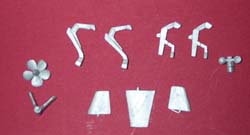 Up on the bridge, the most glaring inaccuracy makes itself apparent in the vertical support for the Satcom antenna. The support never existed, and isnıt even included in the kit instruction drawings. This support cuts through the representation of the center bridge window, which complicates the matter of removing it. Up on the bridge, the most glaring inaccuracy makes itself apparent in the vertical support for the Satcom antenna. The support never existed, and isnıt even included in the kit instruction drawings. This support cuts through the representation of the center bridge window, which complicates the matter of removing it. The modeler will also need to cut rectangular openings on the bridge wings for the ladders that went from the 02 deck to the bridge. Up on top of the pilot house, the modeler might want to replace the rather thick last sections of the bulkhead and replace it with railing with a tissue paper covering. The gun director seems a little thin, and the dish is too far forward. Some minor surgery may be neded to set this right. Strolling back to the 03 deck, the detail nuts will want to look for photos that show the location of the mounts for the .50 caliber machine guns typically installed one per side on the 03 level. 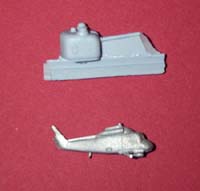 From here, everything looks good until you get to the flight deck. The track for the telescoping hangar is missing, as is the conveyor belt door that was located on the starboard side of the rear of the fixed part of the hangar. The helicopter controllerıs station could also use some window detail. The flight deck itself is a little short; it had some overhang, which was useful in storing random equipment (like the quarterdeck watchıs podium and gear) that wouldnıt fit anywhere else. The kitıs deck is flush with the rear of the superstructure. Also, there are now tie-downs marked out on the flight deck. From here, everything looks good until you get to the flight deck. The track for the telescoping hangar is missing, as is the conveyor belt door that was located on the starboard side of the rear of the fixed part of the hangar. The helicopter controllerıs station could also use some window detail. The flight deck itself is a little short; it had some overhang, which was useful in storing random equipment (like the quarterdeck watchıs podium and gear) that wouldnıt fit anywhere else. The kitıs deck is flush with the rear of the superstructure. Also, there are now tie-downs marked out on the flight deck. The kit includes both the BPDMS launcher and a CWIS. The launcher looks great, except for a minor air bubble in the front of one tube. The detail freaks will want to add vertical stanchions to the overhang of the flight deck. Although the rear capstan is present, the hatch for loading supplies is missing. 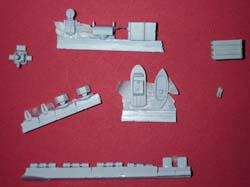 Now that weıve strolled the ship, letıs go back to the boat decks. The two boats included--a 26-foot motor whaleboat and the 26-foot personnel boat used as the captainıs gig--are very nicely done and need only careful painting to look nice. The addition of propellers would further enhance them. These attach to white metal davits with photoetched ³falls.² The construction of these boats will undoubtedly be less difficult and frustrating than the task of operating the real davits. Now that weıve strolled the ship, letıs go back to the boat decks. The two boats included--a 26-foot motor whaleboat and the 26-foot personnel boat used as the captainıs gig--are very nicely done and need only careful painting to look nice. The addition of propellers would further enhance them. These attach to white metal davits with photoetched ³falls.² The construction of these boats will undoubtedly be less difficult and frustrating than the task of operating the real davits. The details are very well rendered. The life raft cannisters are done in resin and go on photoetched racks. White metal stabiliser fins, screw, rudder and mast top provide strength in key areas. The Seasprite is a lovely model all on its own. The brass is really well done, with such touches as anemometers already engineered into the yardarm. Conclusion The very few and very minor discrepancies Iıve pointed out should indicate just how good this model is. If you can please someone with intimate knowledge of the subject, youıve done well, and my hat is off to White Ensign Models for this wonderful rendition of a ship for which I feel great affection. | 






|